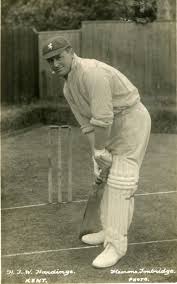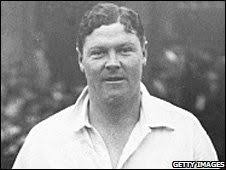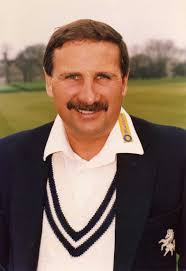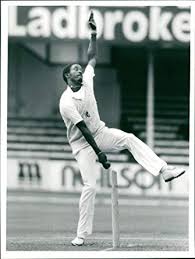Whenever I find it a bit hard to drop off – a rare occasion, I must admit – I like to amuse myself until sleep overtakes me by selecting different cricket elevens, according to whatever strange criteria I may decide on at the time.
The other night, I began wondering about Kent’s all-time greatest eleven, made up only of players who each had at least three forenames – the ones who were obviously so socially acceptable that their parents could afford to give them three names each. So after several hours tossing and turning in the wee small hours, here is my team, in batting order. I challenge anybody to come up with a team to beat this lot.
To open the batting, who else but Robert William Trevor Key? The man is a true Kent legend, the scorer of more runs at Canterbury than anybody in history and one of many Kent captains with three initials, four of whom are in my squad. Keysey is also the holder of the record for the highest score ever made by a Kent batsman in Tests, and the only Kent man to make a Test double hundred. An easy choice, though we may have to hide him in the field.

HTW ‘Wally’ Hardinge
To open with him, I have picked Harold Thomas William Hardinge (known to all as Wally – yet another name), who played more matches for Kent than anybody apart from Frank Woolley. From the year of his debut at 16 years and 111 days in 1902, until 2006 he was the youngest player ever to play for the county, and only Ames and Woolley have scored more hundreds than the 73 he made for the county. Only Woolley (who annoyingly had only two initials) has scored more than his 32,549 runs for Kent, and he took 370 wickets as well, so he is, I would suggest, an uncontroversial pick. What’s more, as an international footballer too, he’d be the one man to beat Keysey at keepy-uppy.
At number three, I have chosen Arthur Percy Frank Chapman. A troubled character, whose love of a drink severely restricted his playing career and his life expectancy, but nevertheless on his day he was a world class batsman. He captained Kent from 1931 to 1936, and also captained England in all but nine of his 26 Tests. For his exhilarating presence on the field, he is a natural choice.

APF Chapman, captain of England and Kent (in that order)
The next man in is playing purely as a batsman, despite many considering him to be Kent’s finest wicket-keeper. I am referring, of course, to Leslie Ethelbert George Ames. I assume you all know of his many achievements and records, as both player and manager, but he has a rightful claim to be the most influential person at KCCC in the twentieth century. And he was a lovely man, to boot.
At number five, we find Richard Norman Rowsell Blaker, a hero of the 1906 Championship title season, but, as an amateur with other business interests, only briefly able to show off his undoubted batting talents. He was also, by all accounts, a quite brilliant fielder with a rocket throw from the boundary. We will include him on the basis of his 1906 form.

A.G.E. Ealham, a greatly underrated cricketer and captain
Taking up the number six position is the man I have also appointed as captain, Alan George Ernest Ealham. One of the county’s most successful captains, in 1978 he led us to the double of the Championship and the Benson and Hedges Cup (as any fule kno). An often underrated batsman, who nevertheless scored almost 11,000 runs for the county, he was infamous around the county circuit as the best outfielder of his day. Few batsman risked a run on his throw, and nobody risked it twice.
At number seven, I have put in an overseas player, Eldine Ashworth Elderfield Baptiste. I don’t think even he would suggest that he was our greatest overseas player of all, given the competition from men with no more than two initials, such as Messrs. Hooper, De Silva, Asif, Shepherd and others, but he was plenty good enough to be a pillar of the side throughout most of the 1980s, with his quick bowling and his aggressive batting, which brought him three hundreds for the county.

E.A.E. Baptiste, in his Kent colours
Our wicket-keeper comes next, and who else could it be than Alan Philip Eric Knott? Well, actually, our three-initialled squad is overloaded with keepers, what with LEG Ames and also two other England keepers, William Howard Vincent Levett and Edward Ferdinando Sutton Tylecote, but it was not hard to pick the great Knotty, especially having already found room for Ames up the order.
Our last three places go to men who would not make much claim to the batting skills, but as bowlers are usually the professional workhorses of the side, it was fairly surprising to find three decent bowlers with the well-to-do amateur’s three initials apiece. At number nine, I will pick Douglas Vivian Parsons Wright, the man with more first-class hat-tricks than anybody else in history, a leg-spinner whose quicker ball was seriously fast. In a career severely restricted by the Second World War, he still took 1,709 wickets for Kent, and became the club’s first professional captain in 1954.
Our two opening bowlers, at numbers ten and eleven, are John Colin Theodore Page and Kevin Bertram Sidney Jarvis. Colin Page was a hardworking and underappreciated bowler for Kent from 1950 to 1963, during which time he took 521 wickets, including five wickets in an innings 22 times, and after he retired, he became an even better coach, and a crucial backroom boy behind Kent’s glorious team of the 1970s. Kevin Jarvis, comfortably the worst batsman in this side, was from the mid-seventies to the late eighties, our leading strike bowler. His career overlapped those of John Shepherd, Graham Dilley and Richard Ellison, as well as overseas players Baptiste and Terry Alderman, but for a decade and a half he was the main man, consistently taking more wickets than he scored runs, and entertaining the crowds whether batting or bowling.
So that’s my eleven. Several players almost made it, including a fistful of captains – CHB Marsham, LHW Troughton and FGH Chalk. There wasn’t quite room for GJV Weigall, JCJ Dye or CJC Rowe, nor for two New Zealanders of recent vintage – TWM Latham and JDS Neesham. But we did fit in an Ernest, a Theodore and a Bertram, which is a fine achievement, so I can now settle down on my pillow and go to sleep.
Goodnight, all.
Leave a comment